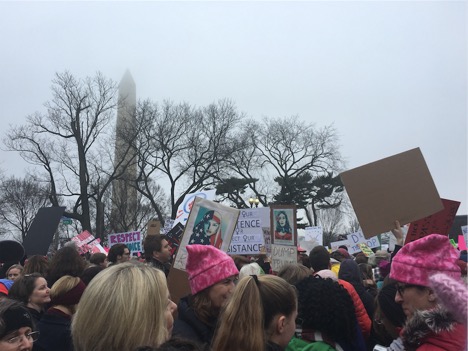On Being a Young Woman at the Women’s March on Washington

Too many people to move. The Women’s March on Washington was at a standstill, but spirits were in full force as women across the globe packed together to fight for their rights.
I’ll admit: I rather begrudgingly dragged myself out of bed at 5:30 in the morning and didn’t even attempt to smile as I waited in the frigid, sunless air for a coach bus traveling to D.C, alongside a mob of peppy and chatty mothers, my own included. I spent the bus ride asleep next to my sister. I imagine the hundreds of thousands of other women traveling to Washington had a similar experience, but it didn’t show when the subway doors opened.
A pink clad crowd, buzzing with energy and fervor, rushed onto the subway. Smushed into a 2-person seat, my mom, sister, and I examined the masses. A beaming woman, toting a large plastic bag, approached us. She offered us one of many handmade pink hats with cat ears, named “Pussy Hats” (in response to Trump’s earlier words), to each attached a little note from the maker voicing their support for the march. It was baffling and unexpected – because I had no idea what to expect. People across the country were united, sharing their support in any way possible.
We traveled through the streets of D.C. And while we were wandering somewhat aimlessly, there was not a single moment that I couldn’t see another couple hundred people around me.
What kind of amazed me was that in the 14 hours I spent at the march, no one said anything negative or rude. It was crowded and cold but not a single person complained. Even when people were pushed into others amidst the mass of people, all you would hear were polite apologies and probably a hopeful conversation.
That was the magic of the march.
Ringing in the chants, (“Show me what democracy looks like! This is what democracy looks like!”), cleverly crafted onto a poster, apparent on the determined faces of all walks of life, was the passion and hope and inspiration that colored the day. It was hard not to feel the energy, and optimism, when I realized this truly is what democracy looks, and feels, like.
The pulsing energy of a female drum group radiated through the crowds, the people parting to allow them to pass down the street. There appeared no room to move, but somehow, everyone found a way.
I saw fathers, hoisting their young daughters above their shoulders to take in the magnitude of the crowds; mothers, hand in hand with their teenage sons; sisters in their late 70s linking arms and marching; college students sporting pink hats and school apparel; and kids perched in trees leading hundreds in chant. I saw a country united. It was like the ultimate sorority, a sisterhood to top all sisterhoods (with a surprising amount of brothers).
There’s an element of fear associated with the march’s purpose; a fear that women’s rights: to equal pay, equal health care, the option of a safe abortion, were in danger; but the march was one of hope. It was not, despite how some perceived it, a protest against Trump. I think some got carried away with their dislike of Trump. Chants like “Hey hey, ho ho, Donald Trump has got to go!”, while catchy, weren’t the truest message of the march.
We were there because women’s rights are human rights.
It was a powerful day, full of powerful people. I was proud to be a woman.
Change is never immediate, but it is the outspoken voices that motivate it. It is the responsibility of everyone to speak up. You are not excused because of your gender; you are not excused because of your race or your privilege; you are not excused because you are unaffected. If you are at all concerned, it’s not enough to simply say it. Act. Because this is what democracy looks like.

Senior Juliet Milani is thrilled to serve as one of the Banner’s executive editors this year! In addition to writing and editing, she enjoys playing...

